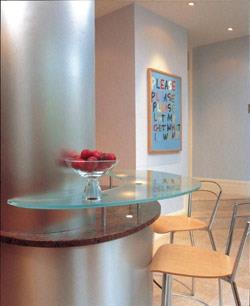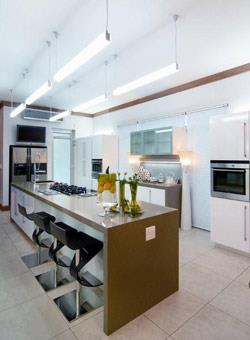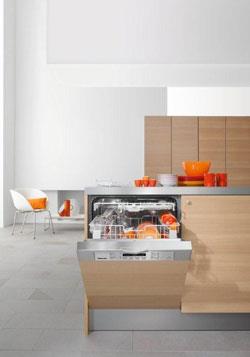 Most families want an attractive dining area for main meals taken together and one of the great pleasures in home life is inviting friends to dinner parties. However, if you need more space for hobbies, work projects or if you want to extend your living area, the dining room is an obvious choice for annexing.
Most families want an attractive dining area for main meals taken together and one of the great pleasures in home life is inviting friends to dinner parties. However, if you need more space for hobbies, work projects or if you want to extend your living area, the dining room is an obvious choice for annexing.The kitchen makes an excellent alternative, either for a permanent dining area or for occasional use. Meals today are mostly informal, sometimes eaten by only a few members of any family at one time because of hectic work and social schedules. Many children and teenagers prefer snacks, and breakfast and lunch are often eaten in relays as the family members come and go. So it hardly makes sense to keep a large space permanently free for setting a table if you can eat just as conveniently elsewhere.
Dining in the kitchen has many advantages because it is the source of food. Some cooks dislike being cut off from the family or guests during meal preparation and an eating area in the kitchen helps prevent this kind of isolation. More of the family are likely to get involved in the cooking if they can see it happening. Meals can be served directly from the stove, eliminating serving dishes and return trips from separate rooms for second helpings or forgotten items. Crockery and cutlery go directly into the sink or dishwasher, and most of all; the kitchen is a warm and inviting room.
Practical considerations
 The major limitation to kitchen dining is the space available. However large the kitchen is, appliances, storage and food preparation can seem to demand all the space there is. In any room less than five metres squared, even a narrow breakfast bar is really out of the question. But careful redesigning of the layout of larger rooms, will allow them to double as a dining area without being less practical for their former functions.
The major limitation to kitchen dining is the space available. However large the kitchen is, appliances, storage and food preparation can seem to demand all the space there is. In any room less than five metres squared, even a narrow breakfast bar is really out of the question. But careful redesigning of the layout of larger rooms, will allow them to double as a dining area without being less practical for their former functions.There are two ways to create eating space in the kitchen – a surface which remains always in view, even if it is a moveable table, and one that folds or slides away when not in use. The choice between these will be dictated by the dimensions of your kitchen and the facilities of your family's needs. Remember that an eating surface can double as a worktop when not being used for meals.
The most common layout design for a kitchen is the L-shape, with two adjacent walls to house units and appliances; the U-shape, with three walls occupied by fitments; and lastly, the galley-shape, where opposite walls are utilised. The first two may leave sufficient floor area unused to house a free-standing table or have wall space for a wall-mounted, foldaway model. Galley kitchens rarely allow for either of these alternatives, but may be wide enough for a pull-out table to be installed below the worktops. As a last resort, removing a standing unit will open up enough of a gap to fit in a knee-hole eating area.
When rethinking your kitchen layout, bear in mind that there should be enough space around the eating surface for diners to sit in comfort without obstructing movement around the room unnecessarily. You can free the floor area when not dining by opting for stools, which stow neatly away under the table or fold-up chairs that can stack against an unused wall.
Breakfast bar ideas
 If you want a more casual sit-up, rather than sit-down arrangement, a breakfast bar may be the answer. However, as these should be the level of the rest of the worktops (about 900mm), they require bar stools for the diner and this makes them unsafe for very young children.
If you want a more casual sit-up, rather than sit-down arrangement, a breakfast bar may be the answer. However, as these should be the level of the rest of the worktops (about 900mm), they require bar stools for the diner and this makes them unsafe for very young children.A breakfast bar needs to be little more than a wall-mounted shelf and it can be sited in a traffic zone not in use during meal times. Or it can be made as a fixed peninsular unit, jutting out into the kitchen and acting as a divider. In either case, leaving room for the stools under the eating surface offers the best space-saving potential.
With the peninsular unit, it may be possible to install a wide enough surface for shallow shelves to be fitted beneath it to store crockery and other kitchen equipment. There may even be sufficient clearance beneath the worktop to allow drawers for cutlery to be installed. Wall shelves fitted above the end of the nit can house small appliances such as toasters and percolators likely to be needed during meal times.
Opening up a dining hatch
 If you have a serving hatch linking the kitchen and existing dining room, and space within the kitchen is at a premium, you may consider enlarging the width of the hatch. By installing a shelf like a breakfast bar, you can create a two-way effect that allows diners to eat at both sides of the opening. You can even take this one step further and demolish part or all of the wall between the kitchen and the dining room, and use the resulting space to build a peninsular dining unit on the line of the demolished wall. This arrangement has the advantage of making a small kitchen seem larger and linking it to the rest of the house, while the existing dining area is freed for other leisure purposes. This particular open-plan layout is often used in modern architecture – with the kitchen, dining room and lounge all forming part of one seamless space.
If you have a serving hatch linking the kitchen and existing dining room, and space within the kitchen is at a premium, you may consider enlarging the width of the hatch. By installing a shelf like a breakfast bar, you can create a two-way effect that allows diners to eat at both sides of the opening. You can even take this one step further and demolish part or all of the wall between the kitchen and the dining room, and use the resulting space to build a peninsular dining unit on the line of the demolished wall. This arrangement has the advantage of making a small kitchen seem larger and linking it to the rest of the house, while the existing dining area is freed for other leisure purposes. This particular open-plan layout is often used in modern architecture – with the kitchen, dining room and lounge all forming part of one seamless space.The final effect
 The other points to bear in mind when planning a dining area in the kitchen, concern creating as pleasant as possible an environment for eating. Try to site the table so diners will not have to stare at an array of dishcloths and dirty pots during meals. Place the table as near the window as possible, as this is the natural light source. Fit a decorative blind or hang curtains to disguise an unattractive view. Cunning lighting by spotlights or dimmer switches controlling the lighting intensity to suit the activities of different parts of the room helps enormously. This enables you to black-out the work areas and create a cosy effect for dining at the flick of a switch.
The other points to bear in mind when planning a dining area in the kitchen, concern creating as pleasant as possible an environment for eating. Try to site the table so diners will not have to stare at an array of dishcloths and dirty pots during meals. Place the table as near the window as possible, as this is the natural light source. Fit a decorative blind or hang curtains to disguise an unattractive view. Cunning lighting by spotlights or dimmer switches controlling the lighting intensity to suit the activities of different parts of the room helps enormously. This enables you to black-out the work areas and create a cosy effect for dining at the flick of a switch. By far the best way to tackle kitchen dining is to integrate the various fixtures and fittings to blend attractively. Smarten up the sink or cooking areas if either is unsightly. The dining apparatus should not be too canteen-like or too grand. Use bright colours for chairs and table surfaces, and perhaps match table cloths and seat covers. – Antonella Dési
Pictures
Images courtesy of:
- Miele
- Nico van der Meulen Architects
- Reto Kitchens
- The Kitchen Clinic
For more information click here to visit the The Kitchen Clinic website.
For more information click here to visit the Reto Kitchens website.
For more information click here to visit the Nico van der Meulen Architects website.
For more information click here to visit the Miele website.
Property News
Click here for more property news articles.
Need a blog?
Start your own blog with a free blog from 24.com.








